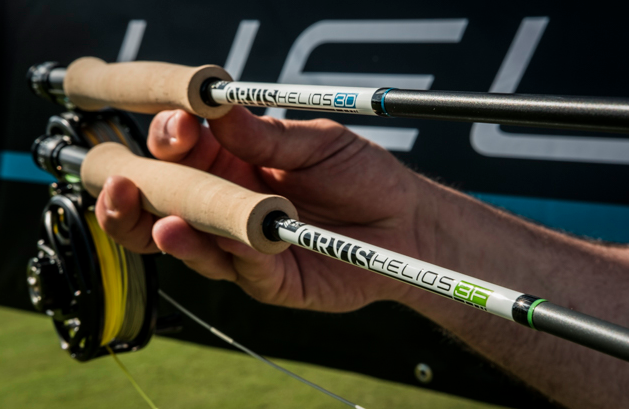The new Orvis Helios 3
Editor’s note: The following is courtesy of Angling Trade.
Orvis Helios 3
Yeah… it’s all that. Worth the wait. Deserving of the hyp
e.
Honestly, it had to be, because Orvis is going all-in with this rebranded flagship rod. The Manchester marketing machine will no doubt drive sales, but at the end of the day, there is a substantive performance characteristic that serves as the unique selling proposition: accuracy. As we reported in the recent print issue of Angling Trade, the blank is constructed in a manner that affords easy loading (that the caster immediately feels), so it generates line speed without redundant false casts.
More importantly, it tracks and stops with clean precision. There’s no wobble at the delivery. The tip action stops and sticks, and thus the fly goes where the angler wants to send it. What that really adds up to is a rod that negates the need for redundant (and fish-spooking) false casts.
You don’t have to be a professional caster to feel the benefit, but in skilled hands, it’s eye-opening. We’ve been fishing it for two months now, and we like it more now than we did on day one. That’s not at all to say we didn’t like it at first. To the contrary, we’re gaining appreciation as we realize what the rod can do in various fishing situations.
I’d rather love a rod after months (or years) of fishing, than be smitten at a casting pond but wonder where the magic went when I’m trying to drop a size #20 Trico pattern on a sipping brown trout. You really need to see it for yourself.
—Kirk Deeter
Scott G Series
 Scott Fly Rod president Jim Bartschi held this one close to the vest, and wouldn’t spill the beans on details until we actually had it in our hands and took it to the river.
Scott Fly Rod president Jim Bartschi held this one close to the vest, and wouldn’t spill the beans on details until we actually had it in our hands and took it to the river.
But he did say this was the most significant fly rod family Scott has introduced in many years. That’s bold talk for a company that’s racked up substantial award-hardware in recent years with the launches of Radian, and later, Meridian.
But it’s true… and sweetly ironic that it comes in the form of a relaunched “G” series that served as the company’s bread-and-butter for years. I love the original G series, and am on record, pining for the days of the old classics, like the G, the Sage RPL, and the Loomis GLX and Winston IM-6.
When I got the new Scott G (a 4-weight) I was smitten by the aesthetics. Still, I went to my gear vault and dusted off old “Uncle Henry” a Scott G circa 1992, and then shot off to the pond for a side-by-side. Still fond of Uncle Henry, but the new G is a marvel. The reborn G has that clean, classic medium action (all about feel and grace) but a little more oomph and pizazz, thanks to modern materials and components. It’s a really, really fine line to resurrect a classic because you have to be true to the roots, but it has to be better. The new G is both. An instant classic.
—Kirk Deeter
St. Croix Imperial (Redux)
Are you sensing a theme here? Legendary names, retooled, restyled for a new era? A nod to the past with a focus on the future? Good. So do we.
And St. Croix is right in that mix as well with the advent of an all-new for 2018 Imperial. Imperial has made a living for the past decade or so by being a strong performer, with good looks and flash, at a reasonable pricepoint. In this case the new Imperial ranges from $230-$330, depending on size and model. They feature high-modulus/high-strain SCIV and SCII graphites in different points on the rod, and slick components.
Most compelling, perhaps, is that the rods carry a 15-year transferable warranty, and are manufactured in the United States. This is the rod you recommend to 99.99 percent of real-world anglers who likely cannot feel the difference between $300 and $800, and they’re not buying the patter meant to get them to shell out another $500.
— Kirk Deeter



